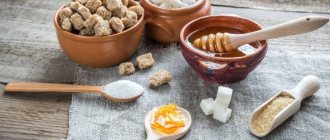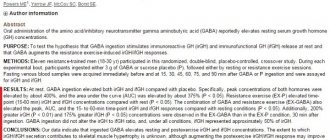Sweeteners
These substances are probably one of the most popular types of food additives for the confectionery industry. As a rule, to make a dish sweet, you need to introduce glucose. It is a white powder that is highly soluble in water. It has a number of well-known substitutes:
- fructose (also a white powder used in dietary nutrition, sweeter than glucose);
- sucralose (also sweeter than sugar and resistant to high temperatures);
- glycerin (trihydric alcohol, which has a sweetish taste, but less rich than sugar, this gives dishes a delicate soft shade);
- maltodextrin (powder consisting of saccharides, we will discuss it below).
Maltodextrin as a substance
This ingredient, index DE 18-20, is a complex mixture of molecules of maltose, glucose, maltotriose and some polysaccharides. It is obtained industrially by hydrolysis of starch (rice, wheat and corn). Special enzymes with acids are also involved in the process.
To do this, you need to remove unnecessary impurities from the raw materials, sift them, soak them and leave them to swell and soften. A suspension is formed from the mass (otherwise called starch milk), which is separately processed in a centrifuge. The result is a white or cream-colored powder.
Maltodextrin in baby food - is it dangerous for the child?
The additive is a type of starch and is included in numerous infant formulas. This component is designed to help break down microelements, which is especially important for those children who have problems with the gastrointestinal tract. If a child suffers from constipation or, conversely, loose stools, it means that the milk formula was chosen incorrectly and most likely does not contain maltodextrin.
In a diet to which dietary supplements are added, the problem with the absorption of substances, even in the presence of gastrointestinal problems, is almost completely eliminated. Children who eat formulas with maltodextrin receive a large amount of energy even when they eat only small portions. Of course, if a child has healthy digestion and loves cereals and milk, then there is no need for nutritional supplements. He can cook regular baby food without any extraneous additives.
Properties of maltodextrin
The additive has important characteristics:
- unsweetened taste (or slightly sweet);
- colorlessness;
- no odor;
- the ability to create the structure of the product: depending on the technical parameter called dextrose equivalent (DE - reducing ability relative to glucose in terms of 100 grams of dry matter), the additive can thicken the consistency and make it more viscous;
- acts as an alternative to fat;
- increases the intensity of taste;
- adds sweetness;
- stops crystallization;
- increases the volume of raw materials for the product.
Experts believe that this rich range is directly related to the DE value. If it is minimal, then all properties are weakly expressed, and the sweet taste is completely absent. If the value increases, the taste appears and the properties are optimally expressed.
Benefits of maltodextrin
The supplement has a lot of positive aspects:
- it is digested more easily than heavier carbohydrates;
- is a reliable source of energy;
- resistant to the effects of gastric juice, is not processed by it and thus stimulates gastrointestinal motility;
- increases the satiety of the dish, replacing both sugar and starch at the same time;
- dissolves easily without forming lumps;
- the sweetness of maltodextrin is much more moderate than that of other additives;
- effectively reduces production costs.
Summarize
- Maltodextrin is a simple carbohydrate, inexpensive and quickly stored in fat.
- Present in sports nutrition to indicate the absence of sugar in it. But, due to its similarity, it is no better than it, and costs 2 times more.
- Main functions: weight gain, surge and restoration of energy. Maltodextrin is best used before or after training to close the protein-carbohydrate window.
- It has no side effects if you do not abuse it.
Maltodextrin is a carbohydrate that they try to push on athletes as an analogue of sugar. But he is no better. It does not harm the body, but it also does not provide any particular benefit, either for an athlete or for an ordinary person.
This is far from the best source of carbohydrates and easily leads to obesity. As a replacement, it is better to use complex carbohydrates: porridge, bananas, durum pasta.
Application
Due to the above properties, maltodextrin is widely used in the food industry. It is placed in:
- dairy products - yoghurts, kefir, whey;
- baby food;
- confectionery products - cakes, pastries, souffles, creams, jellies, confiture, jam, candies, chocolate, ice cream, chewing marmalade;
- bakery products;
- dietary products;
- chips, crackers, ready-made snacks;
- sausages, frankfurters, small sausages, sauces, mayonnaise;
- puddings;
- beverages.
Here this additive demonstrates its multifunctionality in practice:
- maintains the structure homogeneous;
- makes mixtures highly soluble;
- helps achieve the desired consistency;
- helps dissolve proteins;
- facilitates the process of introducing other ingredients (especially dyes and vitamins);
- increases the freezing temperature of products;
- provides their energy value without exceeding the proper level of sweetness.
Maltodextrin is considered one of the most modern and convenient additives in current production precisely because it takes on several tasks at once. This reduces the cost of creating products and makes them high quality and attractive to consumers.
What is maltodextrin: benefits and harms
Maltodextrin is a biologically active additive (BAA) and is actively used in the food industry. Maltodextrin is most often added to sweets and baby food than to other products. Bakery and confectionery products contain dietary supplements in low concentrations. Maximum concentrations of the additive are included in sports nutrition. Dietary products also contain this dietary supplement, since it acts as a substitute for sugar, that is, it is a substitute.
Maltodextrin is obtained by processing starch. The substance has the form of a hygroscopic creamy or completely white powder. It can perform the following functions:
- Act as a leavening agent, which is added to the dough when kneading.
- Act as an emulsifier in milk.
- Promote the rapid dissolution of products, for example, powder mixtures.
- Be a thickener to achieve the desired consistency of the product.
- Inhibit oxidative processes, which allows you to preserve the commercial color of products longer.
- Give jelly form to food products of the appropriate category.
- Improve the absorption of substances in the gastrointestinal tract, which, of course, is an advantage for the consumer.
The list of properties of maltodextrin is impressive, but the question of how harmless or beneficial it is for the body remains open. Manufacturers benefit from the use of this additive. It allows you to maintain the shape and brightness of sweets with candies, and the cookies remain crumbly. Maltodextrin is most often produced as corn or potato starch. The powdered mixture enhances taste perception, that is, the sensations after consuming a product with this additive are much brighter and more pleasant. In addition, the substance absorbs moisture well. The component may also be present in medications that are used in the preparation of dietary supplements.
The main advantage of maltodextrin for athletes is that, when it enters the stomach, it is transformed into glucose, which is a source of energy. Thus, athletes receive a powerful boost of energy for intense training and participation in competitions. Maltodextrin is not a doping agent. The substance is not included in the list of prohibited substances, since it is present in numerous food products, and therefore is freely used by many athletes.
Maltodextrin in products: purpose and important properties
Dietary supplements are added to the following products:
- Children's and sports nutrition to improve the degree of digestibility of microelements included in the mixtures.
- Confectionery products to enhance taste and quality.
- Candies , which allows them to retain their shape and attractive color for a long time.
- Ice cream to extend the shelf life and durability of the treat.
- Sausages in which maltodextrin acts as a source of animal fats.
- Perishable products to preserve marketability and taste during transportation.
- Fast food , in which the additive promotes the crystallization and dissolution of powdered preservatives, as well as the breakdown of semi-finished products.
- Sauces and seasonings to reduce sugar levels and enhance taste.
Maltodextrin is used for spraying fruit and berry crops. The substance helps protect berries from damage by insects and preserve the freshness of the fruit.
Without the addition of this dietary supplement, the products would cease to be what their customers are accustomed to seeing. The absence of maltodextrin in the composition of bread would lead to the absence of a pleasant smell, the jelly would turn into a shapeless cake, and the candies would lose their bright and appetizing color. Baked goods without maltodextrin quickly become stale and tasteless.
Den4ik Answers #8 – MALTODEXTRIN
The effect of maltodextrin on the body
Doctors agree that the supplement not only does not cause any harm to health, but, on the contrary, has a positive effect on it:
- due to its resistance to the environment, it does not break down in the stomach and acts on the gastrointestinal tract like dietary fiber, cleansing it;
- increases the number of beneficial microorganisms;
- removes radionuclides and other harmful compounds;
- lowers cholesterol.
In addition, maltodextrin does not provoke allergic reactions. The only contraindication to it is diabetes (the supplement has a high glycemic index - from 105 to 136, depending on the production method). It is also important that the substance obtained from wheat should not be consumed by people with gluten intolerance. In any case, the ideal recommendation would be to listen to your individual characteristics and, if necessary, consult with specialists.
Common Questions
Controversy continues regarding the benefits and harms of substances. Some claim that it is safe even for children, while others frighten with irreparable consequences.
- Does this substance accumulate in the body and is an overdose possible? – Maltodextrin, like sugar, can accumulate in the body, which leads to weight gain. If consumed excessively, it can cause allergies and flatulence.
- Is the substance considered doping in sports? – Maltodextrin is not included in the list of prohibited drugs and is not a doping agent. Athletes use it as an energy drink and to maintain physical fitness. Due to the large amount of calories, the substance helps speed up the process of gaining muscle mass.
- What is the difference between maltodextrin and dextrose? – The substances have a lot in common. However, there are a number of differences: methods of production, functions, cost, dosage, glycemic index. Both substances can be given to children in small quantities. People who do not exercise should avoid excessive use of supplements.
- What substitutes for maltodextrin are there? – You can use regular honey, dates, guar gum, pectin, stevia (honey herb) as substitutes. These products will help diversify your daily diet and fill any dish with pleasant aroma and taste.
Maltodextrin has a positive effect on muscle mass and fills the body with energy. To avoid negative effects, you should first consult your doctor.
Source
More articles from the “Health” section










